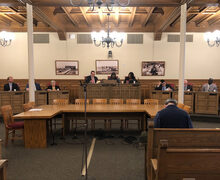Cash flow: As SU continues to expand, officials call increased debt manageable
Chase Gaewski | Photo Editor
Dineen Hall, which will be the home to the College of Law, is the most recent expansions of SU’s campus. The total cost of the project is expected to be $95 million, and will be funded by the Dineen family and campaigns within the law school.
In less than 10 years, Syracuse University has spent more than $300 million on campus expansion.
During Chancellor Nancy Cantor’s tenure at SU, the university has added seven buildings and SU’s debt has almost doubled.
More growth, through buildings like Dineen Hall, the new student space or additional recreational space for students and an updated athletic complex, is already underway. The SU administration says campus expansion is needed and is something the university budget can handle.
“These costs are managed very carefully,” said Lou Marcoccia, executive vice president and chief financial officer. Both the administration and the Board of Trustees must approve a new building beforehand.
In 2004, Cantor inherited $150.5 million in debt from former Chancellor Kenneth “Buzz” Shaw. SU’s debt is now at $396.9 million, Marcoccia said. The current level of debt is manageable and on par with the average national university debt, $348.3 million, he said.
When SU’s next chancellor is brought in, he or she will be made aware of the budget and debt and will be able to provide his or her direction and vision, Marcoccia said. Cantor announced in October she plans to leave the university in 2014.
The current administration argues that campus growth helps SU stay competitive with peer institutions and serve the campus community through updated facilities and space for students. Student enrollment under Cantor has risen 27 percent.
Marcoccia said there are several ways for the university to finance growth, specifically through gifts or grants, loans, the capital project budget and the budget of a specific department, school or college. The university also may seek tax-exempt status on buildings.
The capital budget covers renovations and sometimes building construction. This year’s capital budget is at $25 million and is adjusted for inflation each year, Marcoccia said. Next year’s capital budget is expected to increase, he said.
The university’s overall budget is about $1 billion.
Gifts from donors “represent a significant piece of the puzzle,” but can never be expected to completely cover the cost of a building, Marcoccia said. Individuals and families have given gifts ranging from $3 million to $15 million for buildings since 2005.
Marcoccia said it’s difficult to say exactly how much of a project is funded by gifts to the university.
Dineen Hall, the future home of the College of Law, is the most recent addition to campus expansion. The Dineen family gave a $15 million naming gift and the law school is now campaigning to raise $46 million. The campaign is at $38 million now, with gifts coming from alumni, faculty and staff, according the campaign website.
The total cost of construction is estimated at $95 million, Marcoccia said.
The university’s biggest investment is the Life Sciences Complex at $114.24 million, Marcoccia said. At least $90 million came from bonds, according to articles in the SU Archives.
External funding helped cover part of the cost, including two notable allocations of $5 and $6 million. A $6 million gift from alumni Jack and Laura Milton created the Milton Atrium. New York State Assemblyman William Magnarelli, also an SU alumnus, secured $5 million for the construction of the RESTORE Center for Environmental Biotechnology.
Despite the increase in debt, SU is still considered in good financial shape by both university officials and outside ratings agencies. The opinions of bond rating agencies help determine how much SU can borrow and at what interest rates.
Moody’s Investors Service gives the university high ratings. For the university’s strengths, Moody’s noted SU has been able to draw students from beyond the Northeast, increase tuition revenue and work toward raising $1 billion.
But for the university’s challenges, Moody’s noted there is limited capacity for additional debt given the increase in debt in recent years.
Historically, SU has had a low level of debt, according to bond rating agencies.
In the 29 years Robert Van Gulick, a philosophy professor and member of the University Senate’s budget committee, has been at SU, he said he has never seen the debt so high. He called former chancellors Shaw and Melvin Eggers “debt avoiders.”
Van Gulick said it was worrisome to him that debt for new buildings will keep adding up until it is time to pay the loans. Much of SU’s loan debt is in balloon payments, which means the payment is due all at once at the end of the loan, instead of in increments.
“This is not what the average person would be doing if you were buying a house or a car,” Van Gulick said.
Expansion helps keep SU competitive, like Life Sciences providing students and faculty with current equipment, Van Gulick said. But he questioned the need for all the expansion on campus. He said to consider that, excluding the dining and exercise space, the rooms in Ernie Davis Hall are a quarter of $1 million each.
The university’s budget committee, part of the senate, meets weekly. During meetings with the administration, Van Gulick said officials have expressed that the debt is manageable and is not a concern.
“I don’t have a reason to believe the level of debt is a problem,” Van Gulick said. “I just wish there were less of it.”
Published on April 24, 2013 at 12:47 am
Contact Dara: dkmcbrid@syr.edu | @daramcbride






